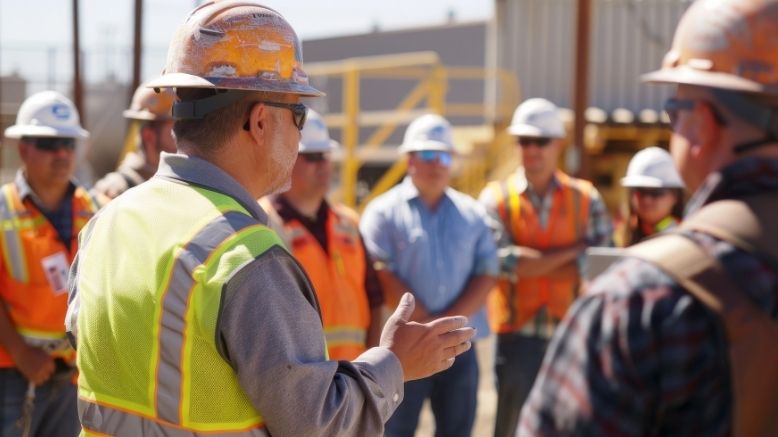— 8 min read
How Dashboards Make Project Data Visible & Usable for GCs


Last Updated Dec 16, 2025

Alex Six
Solution Specialist, C&I Industry Specialist
16 articles
Alex Six is an Enterprise & Strategic Civil & Infrastructure Overlay Account Executive for Procore. Alex has a long background in the construction industry beginning with an internship with one of the biggest contractors in the world, and expanding across projects with teams as small as 4 people and as large as multi-billion dollar budgets with large teams and disciplines. His resume includes Caltrans highways & bridges, Metro light rail & underground, as well as airport runways and utilities.

Kacie Goff
Contributing Writer
90 articles
Kacie Goff is a construction writer who grew up in a construction family — her dad owned a concrete company. Over the last decade, she’s blended that experience with her writing expertise to create content for the Construction Progress Coalition, Newsweek, CNET, and others. She founded and runs her own agency, Jot Content, from her home in Ventura, California.
Last Updated Dec 16, 2025

Every general contractor (GC) has a handful of overarching concerns. They want to keep workers safe, protect their margins, mitigate their risk exposure, and deliver projects on time and on budget.
But as a project moves forward, firms need a way to continually track the changing factors that influence its outcome. Historically, many construction professionals dealt with issues as they arose — and followed their gut in doing so.
Data offers a new path forward, though. With good data collection and analysis, GC firms get better predictive capabilities paired with data-backed decision-making. That, then, begs the question: How do GCs surface the data teams need to best manage all of the projects across the company’s portfolio? Dashboards can be a key part of the answer here.
Table of contents
Powering Real-Time Data Access & Analytics with Dashboards
Without seeing project data, general contractors face real risk.
So much of the success of any construction project comes down to communication. If the right people have the right information communicated to them at the right time, they can move toward the shared goal of an on-time, on-budget delivery. If they don’t, they might move in the wrong direction, introducing issues like quality loss, rework, safety hazards, and more.
With real-time dashboards, GCs get a way to keep the most pertinent information readily available for (i.e., clearly communicated to) whoever needs it. A dashboard is a display that visualizes data in an effort to make it faster and easier for people to digest. The dashboard might synthesize data points into a bar chart that shows nonconforming inspection items by trade or a bolded line item highlighting how many requests for information (RFIs) are overdue, for example.
If you don't have real-time visibility, you're not catching things early enough. You're losing time. You're losing money. Your margins are decreasing. The quality of work is going down. Your reputation with the owners is getting worse. It’s a snowball effect.

Alex Six
Solution Specialist, C&I Industry Specialist
Procore Technologies
A good dashboard presents information in a way that’s easy for everyone to understand. The safety report dashboard might show injuries on a body diagram, for example, making it simple to see what body parts are most at risk.
In short, when a dashboard can surface and organize pertinent project data, it makes it easier for the GC’s team members to stay informed — and to take action when needed.
Better still, team members can use the data from the dashboard to inform that action. This can be particularly helpful for greener employees who don’t have decades of industry experience from which to pull. In other words, dashboards help to move GCs away from the construction industry’s widespread reliance on gut feeling.
As an added benefit, with dashboards established, the GC’s team might find it easier to provide information to external stakeholders. A dashboard created for the owner can provide them with real-time project updates without any added effort for employees, for example.
'We have all of this data. Now what do we do with it?' Dashboards are an easy way to digest data, analyze it, and get prompted about areas you might want to look into.
Alex Six
Solution Specialist, C&I Industry Specialist
Procore Technologies
Dashboards That Benefit All GCs
Most construction software platforms have data analytics tools that can create dashboards, and many have dozens if not hundreds of pre-built options. That doesn’t mean the GC should tap into every available dashboard, though. It’s easy to overwhelm people with too much information.
Instead, the leadership team at the general contractor should sit down and decide what project metrics are most important. What are the issues the company most frequently faces? Where it is lagging behind competitors or regularly having to pull from contingency?
The GC might decide, for example, that it wants to have distinct dashboards for tracking open RFIs and submittals or crew hours. The right dashboards depend on the types of projects across the GC’s portfolio, its self-perform capacity, its region(s), and more.
All of that said, virtually every general contractor benefits from developing some type of dashboard to distill data from these three categories.
1. Safety
First and foremost, general contractors need to prioritize keeping their team and everyone else on the jobsite safe. Dashboards can help them do precisely that.
Track safety incidents and key supporting data like when and where they occurred. Adding other surrounding circumstances (e.g., weather, rework) to the dashboard help GCs identify trends. If they’re seeing a lot of slips, trips, and falls during the winter months, for example, they might invest in anti-slip measures like training and mats.
If GCs want to level-up their safety awareness, they can create a dashboard that captures and tracks near misses, too. Implementing some incentive to encourage self-reporting from affected team members helps here. By analyzing these painless learning points, they get intelligence they can use to keep everyone safer.
2. Cost
Most GCs benefit from having a handful of cost-focused and cost-impacting dashboards running for any given project. Tracking real-time costs — especially comparing estimated to actual — helps GCs see how the project is trending and if any adjustments need to be made.
Since productivity plays a role in project costs, GCs often benefit from also developing a dashboard to track what’s getting done and how long it’s taking. They can then see what kind of resources are being allocated and what kind of output is being achieved. If installing a component is taking its self-perform team longer than expected, for example, a dashboard often helps teams catch that earlier. This gives the GC more ability to make adjustments to avoid a labor cost overrun.
These dashboards can also support revenue generation and cash flow. If the GC is on a project with a small margin and plans to use change orders to pad that, they need to be diligent in managing those change orders.
A dashboard makes it easy to see which ones are tied up in negotiations and which need supporting documentation. Continually providing what’s needed — including nudges to other stakeholders — to move those forward helps the GC bolster its profitability on the project.
3. Schedule
While experts spend a lot of time creating plans for construction projects, things almost never go completely as anticipated. As things get moved around, the GC needs to understand what’s changing and how it’s affecting their project milestones.
A schedule-focused dashboard, then, is key. A simple yet powerful option here: A dashboard that compares what’s actually been completed to the schedule. This helps teams see how the project is trending and where intervention might be needed.
Subsidiary dashboards can help GCs track other factors that impact the schedule, including:
- Material lead times and delivery logistics
- RFIs
- Submittals
Setting up alerts when there are significant deviations from the schedule helps people spring into action when needed.
Stay updated on what’s happening in construction.
Subscribe to Blueprint, Procore’s free construction newsletter, to get content from industry experts delivered straight to your inbox.

Obstacles: Setup and Buy-In
Dashboards can be a powerful tool for GCs, but getting them functional requires investment from leadership and buy-in from every team member.
First, if the firm doesn’t have a strong internal IT function, it may need to work with its software provider or a consultant to build the dashboards it needs. Key features to implement include:
- Role-based access: Giving the right people the right level of access helps to prevent overwhelm. A project engineer might only need access to a few dashboards that pertain to their work, for example, while executives probably want to see the full critical path method schedule.
- Alerts: Ideally, team members look at the dashboards on a regular cadence (e.g., daily). In the event that they aren’t in this habit, though, alerts based on dashboard data surface problems quickly. The GC can set thresholds attached to its dashboards. If any category starts trending below that threshold, it pings the appropriate stakeholders.
Once the dashboards are set up and accessible to the right people, the GC needs to build a company culture that encourages people in the field to collect data to populate the dashboard. The faster information can get from the jobsite to that dashboard, the sooner decision-makers can leverage it. But requiring consistent manual entry from field team members is a big ask.
Two things can help GCs with buy-in from the field. First, leaders should explain the why behind the dashboards. Showing team members how the safety dashboard surfaces hazards to keep them safer can be motivating, for example.
Secondly, GCs need to appropriately staff. If the data entry needed from the field requires an hour a day, that can’t be added to someone’s already full workday. If it is tacked onto a worker who doesn’t have bandwidth, the entry will be rushed, risking inaccuracies.
Closing the Loop: Using Dashboard Data To Drive Continuous Improvement
Dashboards give GCs a way to benchmark how they’re currently doing, both compared to other projects in the company’s portfolio and the industry standard. Checking those dashboards on a daily basis gives stakeholders visibility into the project. It highlights when and where the team should jump in to correct the course. But that’s not all.
Just like a large language AI model is learning from itself, that's what companies need to do. They need to understand the decisions they’re making off of data. Was it the right decision? Did it go well? Did it not? More importantly, why? And then, incorporate that back into the next decision — so every time, they're getting smarter.
Alex Six
Solution Specialist, C&I Industry Specialist
Procore Technologies
Dashboards from past projects provide a visual to see how those projects performed. They make it easier to pull out lessons learned, which the GC can then apply to the way they bid future jobs. When dashboard data feeds back to the company’s estimators, it closes the data loop.
That increases payoff from all of the effort that went into data entry. The data doesn’t die when the project ends. Instead, it gets pulled into the GC’s company-wide business intelligence, helping to propel future successes.
Was this article helpful?
Thank you for your submission.
0%
0%
You voted that this article was . Was this a mistake? If so, change your vote
Scroll less, learn more about construction.
Subscribe to The Blueprint, Procore’s construction newsletter, to get content from industry experts delivered straight to your inbox.
By clicking this button, you agree to our Privacy Notice and Terms of Service.
Thank you!
You’re signed up to receive The Blueprint newsletter from Procore. You can unsubscribe at any time.
Categories:
Written by

Alex Six
Solution Specialist, C&I Industry Specialist | Procore Technologies
16 articles
Alex Six is an Enterprise & Strategic Civil & Infrastructure Overlay Account Executive for Procore. Alex has a long background in the construction industry beginning with an internship with one of the biggest contractors in the world, and expanding across projects with teams as small as 4 people and as large as multi-billion dollar budgets with large teams and disciplines. His resume includes Caltrans highways & bridges, Metro light rail & underground, as well as airport runways and utilities.
View profile
Kacie Goff
Contributing Writer | Procore Technologies
90 articles
Kacie Goff is a construction writer who grew up in a construction family — her dad owned a concrete company. Over the last decade, she’s blended that experience with her writing expertise to create content for the Construction Progress Coalition, Newsweek, CNET, and others. She founded and runs her own agency, Jot Content, from her home in Ventura, California.
View profileExplore more helpful resources

Defending Against Financial & Legal Risks on Megaprojects
The construction industry has seen marked growth in megaprojects. Some experts classify any project over $500 million as a megaproject, while others argue that the build needs to be $1...

Unlocking Project Intelligence: Moving from Raw Data to Actionable Insights
The construction industry faces a wide range of challenges, from ongoing labor shortages to frequent cost overruns. But some the biggest hurdles all stem from unpredictability. The general contractors (GCs)...

Who is accountable for innovation in construction?
Everyone says construction needs to innovate—but no one agrees on who’s actually responsible for making it happen. Is it the owner? The builders? The tech vendor? Or is innovation everyone’s...

Integrated Project Delivery in Practice: A Framework for Collaboration
On construction projects, traditional delivery methods put different stakeholders in their own silos. While the design team feeds drawings and specifications to the general contractor (GC), the GC’s expertise in...
Free Tools
Calculators
Use our calculators to estimate the cost of construction materials for your next project.
Templates
Find a template to help you with your construction project tasks.
Material Price Tracker
Get the latest U.S. retail prices and view historical trends for common building materials.
Glossary
Explore key terms and phrases used in the industry.
